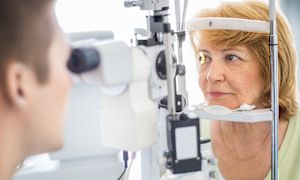Advertisement
Disease of the retina, or the light-sensing portion of the eye, is a major complication of diabetes, and diabetes remains one of the leading causes of severe vision loss, particularly among younger individuals. As a result, most physicians recommend that a person with diabetes see an ophthalmologist at least once yearly.
For routine eye care in a person with diabetes, the ophthalmologist does not have to be a retina specialist. The changes associated with diabetic retina disease (called "retinopathy") can be seen during a standard ophthalmological exam. Mostly these changes affect the blood vessels. There may be areas of slow bleeding or hemorrhaging, aneurysms or areas of scarring or poor blood flow. If the general ophthalmologist sees any abnormality in the retina, he or she will make referral to a retina specialist.
If the retina specialist confirms the retinopathy, the person will usually undergo a fluorescein angiogram. Fluorescein is a dye which is injected into a vein in the arm. It circulates throughout the body, including into the blood vessels in the retina. The pupils are dilated, and a blue light is shined into the eye. The fluorescein dye glows a yellow-green color in response to the blue light. (This is "fluorescence"—the property of giving off a new color when exposed to another color. A common example is the fluorescent dyes used in posters that glow with a visible color when they are exposed to ultraviolet light or "black light," which is mostly invisible to the eye.) When the blue light is filtered, only the yellow-green light of the dye shows up. Since the dye is contained in the blood vessels, this is a way of carefully examining the blood vessels in the retina. This is an essential first step in treating the retina disease. Treatment usually involves laser therapy (or laser "photocoagulation") or the injection of medications designed to slow the growth of abnormal, destructive vessels in the eye.
For routine eye care in a person with diabetes, the ophthalmologist does not have to be a retina specialist. The changes associated with diabetic retina disease (called "retinopathy") can be seen during a standard ophthalmological exam. Mostly these changes affect the blood vessels. There may be areas of slow bleeding or hemorrhaging, aneurysms or areas of scarring or poor blood flow. If the general ophthalmologist sees any abnormality in the retina, he or she will make referral to a retina specialist.
If the retina specialist confirms the retinopathy, the person will usually undergo a fluorescein angiogram. Fluorescein is a dye which is injected into a vein in the arm. It circulates throughout the body, including into the blood vessels in the retina. The pupils are dilated, and a blue light is shined into the eye. The fluorescein dye glows a yellow-green color in response to the blue light. (This is "fluorescence"—the property of giving off a new color when exposed to another color. A common example is the fluorescent dyes used in posters that glow with a visible color when they are exposed to ultraviolet light or "black light," which is mostly invisible to the eye.) When the blue light is filtered, only the yellow-green light of the dye shows up. Since the dye is contained in the blood vessels, this is a way of carefully examining the blood vessels in the retina. This is an essential first step in treating the retina disease. Treatment usually involves laser therapy (or laser "photocoagulation") or the injection of medications designed to slow the growth of abnormal, destructive vessels in the eye.
Schedule an appointment with an ophthalmologist if you, your diabetes care provider, or your optometrist notice any of the following signs:
• unexplained visual problems, such as spots, “floaters,” or cobwebs in your field of vision, blurring or distortion, blind spots, eye pain, or persistent redness• trouble reading books or traffic signs or difficulty distinguishing familiar objects
• increased pressure within the eye, which could be a warning sign of glaucoma. Some physicians and most optometrists routinely test for this.
• any retinal abnormalities. Most endocrinologists, internists, primary care practitioners, and optometrists will test for this but should refer problems with the retina to an ophthalmologist.
• leaking of blood vessels that supply the retina, which leads to retinopathy, the main cause of blindness in people with diabetes
Continue Learning about Eye Care
Important: This content reflects information from various individuals and organizations and may offer alternative or opposing points of view. It should not be used for medical advice, diagnosis or treatment. As always, you should consult with your healthcare provider about your specific health needs.



